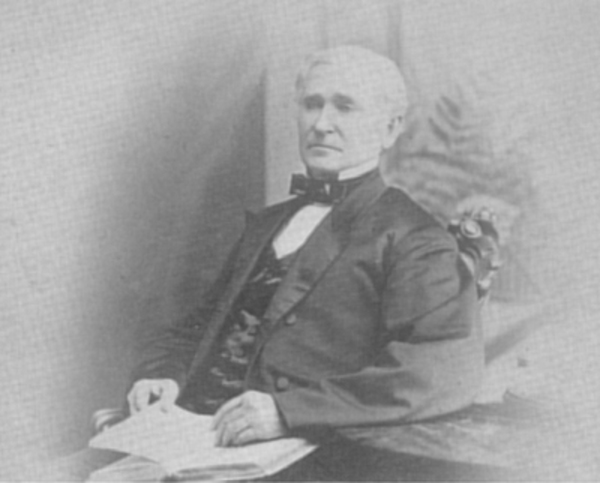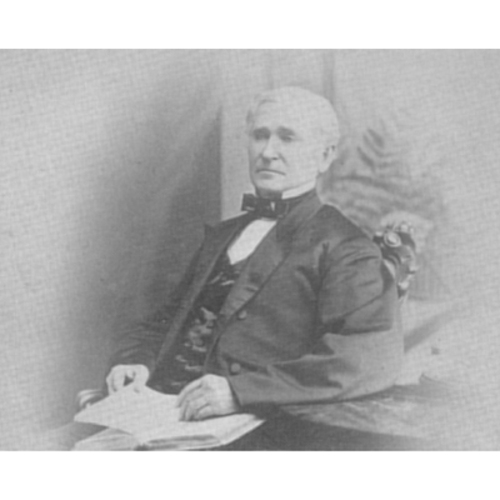
Source: Link
McQUESTEN, CALVIN, physician, manufacturer, and capitalist; b. in 1801 in Bedford (Manchester), N.H., son of David McQuesten, a farmer, and Margaret Fisher; m. first Margarette Lerned (1801–41), secondly Esther Baldwin (1816–51), and lastly Elizabeth Fuller (d. 1897); he had three surviving sons; d. 20 Oct. 1885 at Hamilton, Ont.
Calvin McQuesten graduated with a teaching certificate from Bradford Academy, Bradford, Mass., in 1825 and taught school for two years, possibly at Bradford Academy and then in Washington, N.H. In 1827 he began studying medicine at Bowdoin College, Brunswick, Maine, graduating md in 1829. He practised in Sandbornton Bridge, N.H., before moving in 1832 to Brockport, near Rochester, N.Y., where his practice seems to have prospered.
McQuesten’s first business venture was the establishment of McQuesten and Budlong’s drugstore in Brockport. In 1835 he became involved in another business endeavour. Earlier that year his cousin, John Fisher, arrived in Hamilton, Upper Canada, from New York State to attempt to set up a foundry. Unable to secure credit from local capitalists who viewed Hamilton as a commercial rather than an industrial centre, he sought the financial backing of McQuesten. On 1 Oct. 1835 the two cousins joined with Priam B. Hill of Brockport and Joseph S. Janes of Hamilton to form a general co-partnership to manufacture threshing machines and stoves. Fisher brought his inventions and technical knowledge to the partnership, McQuesten supplied $1,500, Hill provided additional capital, and Janes contributed the land on which the foundry was built.
The history of the company, variously known as McQuesten, Janes and Company, McQuesten and Fisher Company, and McQuesten and Company, provides an example of industrial organization prior to the widespread adoption of limited liability incorporation after the mid century. Partnership was a means of combining the talents and resources of several individuals; however, its inflexibility required the dissolution of the business when new talents were required or active partners wished to resign. In this company the durations of the partnerships were limited to specific periods of time after which outstanding accounts were settled and profits apportioned. In 1836, for instance, Priam Hill moved to Wisconsin Territory and sold out to McQuesten, giving the latter a controlling interest in the business. Partnerships were further dissolved, altered, and reconstituted in 1843, 1848, and 1853; in the last instance six skilled craftsmen employed by the firm were made partners, including three nephews of McQuesten, moulder Stephen Payson Sawyer, machinist Luther D. Sawyer, and tinsmith William W. McQuesten.
After 1835 McQuesten divided his time between his medical practice in Brockport, sales trips for the company, and the purchase of raw materials and equipment from American suppliers. In 1839 he ceased practising medicine and moved to Hamilton to devote his time to the management of the company. Fisher died in 1856 and the following year McQuesten retired, liquidating his holdings, reputedly valued at $500,000; Luther Sawyer then gained control of the foundry and later joined with Hart Almerrin Massey* to form the Sawyer and Massey Company.
McQuesten put his capital to work in both financial and industrial enterprises. In 1860 he held over $32,000 in Gore Bank stock, an interest which led to his election as a director in 1862 and vice-president in 1867. In the latter role he was critical of the direction given the Gore Bank, especially by the president, Thomas Clark Street*, and in 1868 he charged Street with obscuring the excessive indebtedness to the bank of the Hamilton firm of Buchanan, Hope and Company, which had failed the previous year [see Adam Hope], and with over-investment in the Bank of Upper Canada and the Commercial Bank of the Midland District, both of which had failed. These poor investments had severely compromised the bank’s capital. McQuesten had the support of the bank’s shareholders and in 1868 was the only director re-elected. The following year he was a member of a committee, initiated by Æmilius Irving*, that negotiated the merger in 1870 of the Gore Bank with the Canadian Bank of Commerce [see William McMaster]. McQuesten converted his holdings in the Gore Bank into stock in the Canadian Bank of Commerce. He also held stock in other financial institutions such as the Victoria Mutual and Insurance Company and the Dominion Fire and Marine Insurance Company. Having made his money in industry, he reinvested some of his capital in other industrial enterprises including the Ontario Worsted Company, the Canadian Felt Hat Company, and the Hespeler Mills (textiles). He also held shares in the Dominion Salvage and Wrecking Company and the Hamilton Tribune Printing and Publishing Company. The largest portion of his fortune, however, was invested in real estate, principally in Hamilton but also in mortgages on Ontario farms.
McQuesten’s upbringing had been profoundly religious. Most of his life in the United States had been spent in the northeast during a period of intense revivalism. McQuesten became a proponent of evangelical theology and, as an elder, tried to persuade the Presbyterian congregation of Brockport to adopt some of the methods of revivalism, thereby lessening its potentially disruptive power. In Hamilton McQuesten continued his religious activities, devoting his time and money to the encouragement of Presbyterianism. He was prominent in the establishment of the MacNab Street (1854) and St Paul’s (1857) Presbyterian churches in Hamilton, and Knox Presbyterian Church (1874) in Dundas, Ont., and received appeals for aid from Presbyterians in other parts of North America. In his travels through Canada and the United States, he made notes on the architectural and acoustical design of many churches and his advice was heeded in the construction of Central Presbyterian Church (1857–58) in Hamilton. He was also active in the Hamilton branch of the Upper Canada Bible Society as treasurer from 1844 to 1849 and vice-president from 1849 until his death. McQuesten assisted Edward Jackson* with the establishment in 1861 of the Wesleyan Female College in Hamilton, a non-sectarian diploma and degree granting institution; from 1861 to 1872 he was vice-president of the college and then president until his death. After his retirement McQuesten also indulged in his favourite pastime, the study of evangelical Protestant theology, especially the work of Jonathan Edwards. In later years, probably because his efforts to inject American evangelicalism into Canadian Presbyterianism were rejected, he refused to belong to any congregation and built a small chapel on his estate for private use.
Calvin McQuesten, like many of the American immigrants after 1820 who brought either capital or expertise to Upper Canada, contributed to the development of Canadian industry while amassing a private fortune. After Calvin’s death the McQuesten family continued its association with Hamilton. Calvin’s son Isaac Baldwin lived in Whitehern, the house Calvin had bought in 1852, now an historic site. His grandson Thomas Baker McQuesten*, a Hamilton philanthropist, became a minister in the provincial government of Mitchell Hepburn*.
AO, McQuesten papers. HPL, McQuesten papers. Whitehern Museum (Hamilton, Ont.), McQuesten papers. Hamilton Spectator, 21 Oct. 1885. Monetary Times, 6 Aug., 29 Oct., 12 Nov. 1868; 5 Aug. 1869. Compliments of the Sawyer–Massey Co., Limited (n.p., 1906).
Cite This Article
David G. Burley, “McQUESTEN, CALVIN,” in Dictionary of Canadian Biography, vol. 11, University of Toronto/Université Laval, 2003–, accessed December 18, 2025, https://www.biographi.ca/en/bio/mcquesten_calvin_11E.html.
The citation above shows the format for footnotes and endnotes according to the Chicago manual of style (16th edition). Information to be used in other citation formats:
| Permalink: | https://www.biographi.ca/en/bio/mcquesten_calvin_11E.html |
| Author of Article: | David G. Burley |
| Title of Article: | McQUESTEN, CALVIN |
| Publication Name: | Dictionary of Canadian Biography, vol. 11 |
| Publisher: | University of Toronto/Université Laval |
| Year of publication: | 1982 |
| Year of revision: | 1982 |
| Access Date: | December 18, 2025 |



